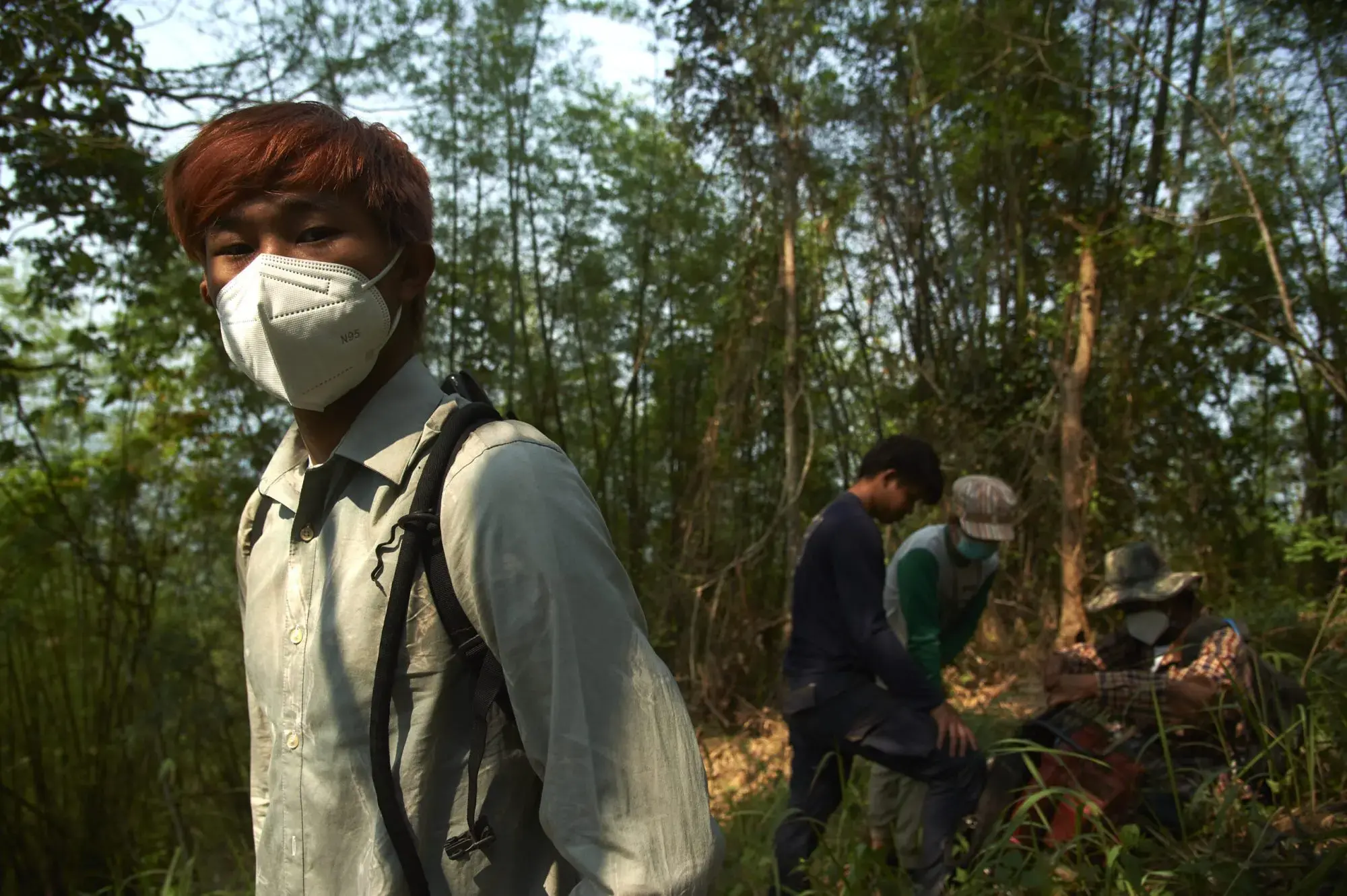
Under last year’s haze that shrouded the region and sent over two million people to hospital, concerned authorities and policymakers have started to dispel the myth that has lasted for over 16 years, demystifying it and discovering the root causes; the vastly burned forests and numerous hotspots, the endless loop of farm life poverty and inequalities and forest and fire reliance, the unregulated free market and expansion of monocropping, and last but not least, the dysfunction of the aged bureaucratic system. They are now developing a more systematic solution comprising short- and long-term measures and policies_from “catching the Big Fish” to an ongoing enactment of the country’s first Clean Air Act.
With a big fire breaking out in Doi Suthep-Pui National Park in the northern tourism city of Chiang Mai last dry season, Praphan Wichaidam, a village head of Pong Nuea village in Tambon Suthep instructed his villagers to lift their guard up high this year, awaiting the burning season to arrive, usually in early February.
Being an iconic national park of Thailand’s North, and dotted with the famed temple and royal residence, its mountains are highly expected from the public to be free of forest fires.
This is in contrast to last year’s facts that the region of 17 mountainous provinces was the champion of forest fires in the country. According to the National Parks, Wildlife and Plant Conservation Department’s examination, hotspots from all sources nationwide were recorded at around 172,000 (The VIIRS sensor system of NASA’s satellites with a spatial resolution of 375m). Of this number, 120,000, or 69%, occurred in forest areas; 70,000 in protected areas of national parks and wildlife sanctuaries and the rest in forest reserves. Of 70,000, over 52,000 occurred in the protected forests in the North already, with Chiang Mai’s hitting the highest record at 7,245 hotspots.
“Ban Pong was in the headlines and accused of causing the forest fires on Doi Suthep although we could not pinpoint who actually caused the flames_my villagers or those next doors. The pressure is on us and we want to be part of the solution, not the problem,” said Mr. Praphan.

As a nonprofit journalism organization, we depend on your support to fund journalism covering underreported issues around the world. Donate any amount today to become a Pulitzer Center Champion and receive exclusive benefits!
Under last year’s haze that shrouded the region and sent over two million people to hospital, concerned authorities and experts have started to dispel the myth that has lasted for over 16 years, demystifying it and discovering the root causes; the vastly burned forests and numerous hotspots, the endless loop of farm life poverty and inequalities and forest and fire reliance, the unregulated free market and expansion of monocropping backed by large agribusiness, and last but not least, the dysfunction of the aged bureaucratic system.

The myth unveiled
As noted by the Pollution Control Department, which monitored the developments of the situation, the hotspots in the North started to hit the record since the middle of February, with a 118% increase compared to 2022; nearly 19,000 (18,988) from 8,698. At the same time, the number of hotspots in the neighbouring countries or the Mekong sub-region by then also rose to 256,700, according to the department (The VIIRS sensor system of NASA’s satellites with a spatial resolution of 375m).
By April, the haze sent over two million people to hospital, with records of respiratory symptoms varying from mild to severe degrees, according to the Public Health Ministry. The ministry projected at that time that the hazardous level of the fine dust that affects people’s health would continue through April and could be at ease in mid-May at the earliest.



At the end of the season (May 31), the northern region recorded around 109,035 hotspots, or a 356% increase from 2022, which stood merely at 23,913. Of these, 86% of them occurred in forest areas and this figure rose to 93% when focusing on only nine mountainous provinces of the Upper North. The rest of 4 to 11% of the hotspots occurred in open fields or farmland in lowland areas and 3% in residential areas, according to the department.
The cumulative hotspots in the Mekong sub-region, meanwhile, stood at almost a million, or 992,718, with Myanmar contributing the most with 413,041 hotspots; followed by Lao PDR (254,734), Thailand (168,392), Cambodia (111,781), and Vietnam (44,770). This was a 103% increase from 2022’s record, according to the PCD, and Thailand’s figure was the highest or 267% increase with 168,392 hotspots compared to 45,930 recorded in 2022.


Amid those hotspots, the country’s protected forests alone were burned down beyond 12.7 million rai out of the total area of 73 million rai. 8.9 million rai of these were in the North (Lansat 8-9 with cumulative counting).

Messing with the forest fires
Nakharin Suthatto, a director of DNP’s Forest Fire Control Division, conceded that last year’s forest burnings were severe and measures implemented to handle the situation were unsuccessful. The DNP by the end of the season called in all forest fire control officials to undertake the After Action Review or AAR to get the lessons learned.
Normally, the DNP will mobilise their officers to manage forest fuels ahead of the burning season. Forest fuels in high-risk areas will be selectively burned and firebreaks will be created to help break forest fires. In the middle of the season, zero-burning may be issued to suppress the burnings when the air pollution gets severe, and closure of protected forests may be executed if necessary along with law enforcement.
“Sometimes, leaves of trees do not fully fall yet, but we have to executive the regulated burnings or can do nothing at all otherwise. And other time, we have to execute it following the delayed arrival of the budget,” said a senior forest fire control official supervising forest fire control areas in the Upper North. Additionally, the forest fire control officers themselves were also blamed as part of the cause of the fires. As they managed forest fuels through regulated burnings, they too tried to avoid being detected by satellites and included in reports of hotspots. So, they burned the forests at night, prompting uncontrolled fires.




As the fires broke out and became uncontrolled, the DNP’s forest fire control officers, over 6,500 of them stationed in 150 forest fire control stations nationwide with over half in the North, were mobilised to dorse the fires alongside volunteers in the areas. Additionally, almost all 250 specially trained forest fire control officers from the special unit known as Suea Fai were called in to help in the mission.
Despite the troop of forest fire control officers and volunteers, the situation had gone from bad to worse and the DNP eventually decided to execute the closure of 104 national parks and wildlife sanctuaries in the region as its last resort.

“Catching the Big Fish”
Alongside experts and strategists of the government and civil society representatives, the DNP this year has proposed a new directive to control forest fires. They have identified “the most burned scars” or the forests which are most regularly burned down. They call them “the Big Fish”.
This requires ambitious efforts from the DNP. According to some senior forest fire control officials in charge of the situation in the North, the critical challenge to the success of the first and foremost measure of forest fuel management still concerns the forest ecosystems and the state budget.
One senior forest fire control official has assessed that the forest fuels in the region are still relatively massive although they were extensively burned down last year. However, according to the new plan, the officers will no longer be pressured by the limited timing. They will manage them following the air conditions and these can be projected and planned through the application called Fire D (Good Fire), just like the local residents who want to use fires to burn their fields. However, the official is rather concerned about this year’s budget as it’s still being debated in the Parliament, almost four months delayed.



“We can say we will stay all day and night to guard the forests,” said the official.
Aside from work on the ground, the new command has also been initiated with different levels and ranks of command introduced. First and foremost are the war rooms at the target national parks and wildlife sanctuaries, and they will be in charge of the fires within 48 hours. The second command is with the war rooms of the DNP’s regional offices, which will be in charge of the fires beyond 48 hours but no later than seven days. And if the fires burn beyond seven days or a week, the command will then be shifted to the provincial war rooms commanded by the governors and DNPs.

The root causes and Clean Air Act
For Dr. Buntoon Sretthasirote, the country’s noted environmental policymaker and chair of the drafting committee of the Clean Air Act sponsored by the government’s Strategic Transformation Office, the root causes of the forest fires in the North lie with farm life poverty and inequalities, their forest and fire reliance, the unregulated free market and expansion of monocropping, and the dysfunction of the aged bureaucratic system.
To start to shift the paradigm, Dr. Buntoon and his team investigated the root causes of the problem, identified them, and came up with solution proposals that were divided into phases; from short to middle and long terms.

Under their proposals, they agreed on the directive proposed by the DNP as the immediate solution for this year and proposed increased support and synergies from other state agencies to help the DNP. For instance, the government must immediately set the budget to back up the DNP’s work, which requires merely 74 million baht, compared to over 38,000 million baht of the damage last year.
These include more synergies and public participation with residents in addressing their farm-based livelihoods and land uses through state mechanisms such as a forest-people co-existence policy and Article 64 under the new National Parks Act that allows people to live in the forests with certain conditions imposed. More synergies and integration of state budget and work across agencies ministries and national committees will also be pushed while a new work structure and system for clean air management will also be established based on data and technology for precise planning and implementation.
New regulations on monocrop farming and a freely unregulated market for monocrop products will also be introduced alongside penalties, and last but not least is the reform of related laws and regulations that help progress clean air management, including the new Clean Air Act.

Thailand Can’s version, meanwhile, is relatively right-based, basing the content on people’s right to clean air. State duties then are expected to follow to help address the problem at its root causes. Other draft acts, including Move Forward, on the other hand, try to address the transboundary problem and polluters’ responsibility with the polluter pay principle as they view the problem as principally resulting from polluters’ acts, especially those in the agricultural industry.
All versions were submitted to the Parliament in mid-January when the Lower House’s MPs voted overwhelmingly to accept them in principle with a majority of 443 votes. A new law vetting committee with 39 members, Dr. Buntoon included, has been set up and is now scrutinising and synthesising those seven drafts for further readings in Parliament. The STC’s version is a prime draft. They have two weeks to finish their work, which is expected to be wrapped up by next week.














